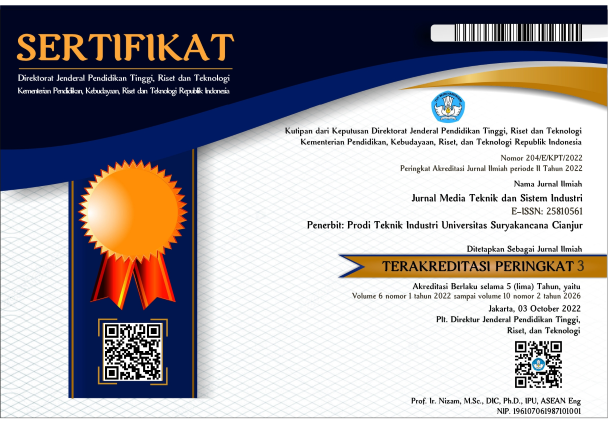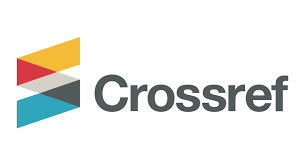Penerapan QFD dan DFA pada Perancangan Produk Tas Laptop Multifungsi
Abstract
Abstract— Laptop usage among students is very important to support the activities and associated costs. There are some conditions of use which are not ergonomic laptop for students, among others, the position of the use of a laptop or desk while no means the use of laptops in the user environment, until the condition of the laptop that is not placed on the surface of the correct. One solution is to use a laptop as a medium backpack laptop-carrier wherever that may be used at once as a table as the supporting facilities to operate the laptop with a more ergonomic. To design such products can use the methods of Quality Functional Deployment (QFD) and further product Assembly analysis using the method of Design for Assembly (DFA). From the results of data collection, data processing and data analysis, it has been concluded that the products are designed is a multifunctional laptop backpack bag products, where these products is a laptop backpack that can be turned into a table, sitting with laptop product development priorities, namely the form of a table that can be folded and made of aluminium, with several other priority specifications in accordance with the results of the analysis using the QFD method. In addition it also acquired a large number of constituent components of a product that is as much as 21 components for sub products backpack laptop, as well as 4 components for sub products desk laptop. Other results obtained through analysis of the DFA is the estimation of the cost of production and Assembly of the products with a total of Rp. 261,500,-, estimated time of Assembly products for maximum 847.3 minutes, as well as the value of the efficiency of the Assembly is 20.2% for sub products backpack laptop, and 1.4% for sub products desk laptop.
Keywords— DFA, Multifunctional, QFD, Redesign, Laptop backpack bag.
Â
Abstrak— Penggunaan laptop di kalangan mahasiswa sangat penting untuk menunjang kegiatan perkuliahan. Terdapat beberapa kondisi penggunaan laptop yang tidak ergonomis bagi mahasiswa, antara lain posisi penggunaan laptop saat tidak ada meja ataupun sarana penggunaan laptop di lingkungan pengguna, hingga kondisi laptop yang tidak diletakkan pada permukaan yang benar. Salah satu solusi adalah dengan menggunakan tas ransel laptop sebagai media pembawa laptop kemanapun yang dapat digunakan sekaligus sebagai meja sebagai fasilitas penunjang untuk mengoperasikan laptop dengan lebih ergonomis. Untuk merancang produk tersebut dapat menggunakan metode Quality Functional Deployment (QFD) dan analisa perakitan produk lebih lanjut menggunakan metode Design for Assembly (DFA). Dari hasil pengumpulan data, pengolahan data dan analisa data, telah disimpulkan bahwa produk yang dirancang ialah produk tas ransel laptop multifungsi, dimana produk ini merupakan sebuah tas ransel laptop yang dapat berubah menjadi meja laptop lesehan, dengan prioritas pengembangan produk yaitu bentuk meja yang dapat dilipat dan berbahan aluminium, dengan beberapa spesifikasi prioritas lainnya sesuai dengan hasil analisa menggunakan metode QFD. Selain itu diperoleh pula banyaknya jumlah komponen penyusun produk yaitu sebanyak 21 komponen untuk sub produk tas ransel laptop, serta 4 komponen untuk sub produk meja laptop. Hasil lain yang diperoleh melalui analisa DFA adalah estimasi biaya produksi dan perakitan produk yaitu dengan total Rp. 261.500,-, estimasi waktu perakitan produk selama maksimum 847,3 menit, serta nilai efisiensi perakitan adalah sebesar 20,2% untuk sub produk tas ransel laptop, dan 1,4% untuk sub produk meja laptop.
    Â
Kata kunci— DFA, Multifungsi, QFD, Perancangan ulang, Tas Laptop.
Full Text:
PDFReferences
Badan Penelitian dan Pengembangan Sumber Daya Manusia, “Survey Penggunaan TIK serta Implikasinya terhadap Aspek Sosial Budaya Masyarakatâ€, Web KOMINFO, September 05, 2018. [Online]. Available: https://balitbangsdm.kominfo.go.id/?mod=publikasi&a=dl&page_id=360&cid=9&download_id=187.
H. F. Tampubolon, A. R. Matondang, dan R. Ginting, “Optimasi Quality Function Deployment Berbasis Model Kano untuk Memaksimalkan Kepuasan Konsumenâ€, eJurnal Teknik Industri FT USU, vol. 1, no. 1. Pp. 7-15, Januari 2013.
E. B. Utomo, dan F. Achmadi, “Pengaruh Kepuasan Konsumen Terhadap Pemberian Garansi Laptop Menggunakan Model Kano-QFDâ€, SENIATI, pp. 88-97, 2018.
A. B. Nasution, R. Ginting, dan I. Siregar, “Penilaian Proses Perakitan Produk Saklar dengan Metode QFD di PT. Xâ€, eJurnal Teknik Industri FT USU, vol. 2, no. 2, pp. 35-41, Juni 2013.
I.D. Widodo, â€Perencanaan dan Pengembangan Produkâ€, 2003. UII Press: Yogyakarta.
DOI: https://doi.org/10.35194/jmtsi.v3i1.557
Refbacks

This Journal is licensed under a Creative Commons Attribution-ShareAlike 4.0 International License.
Jurnal Media Teknik dan Sistem Industri ISSN: 2581-0561 (online); 2581-0529 (cetak).
Gedung Fakultas Teknik UNSUR Jl. Pasir Gede Raya, Cianjur, Jawa Barat 43216| Telp./Fax. (0263) 283578 |E-mail: jmtsi@unsur.ac.id
JMTSI (Jurnal Media Teknik dan Sistem Industri) INDEXED BY :


















